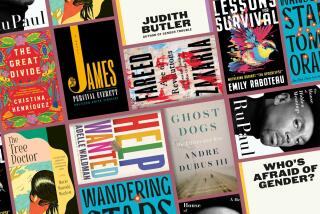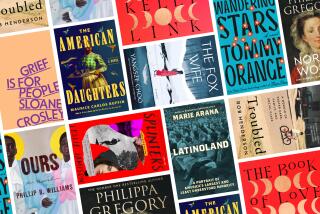Despatches from the Frontiers of the Female...
Despatches from the Frontiers of the Female Mind: An Anthology of Original Stories, edited by Jen Green and Sarah Lefanu (Salem House: $4.95). One would think that “Frankenstein,” Mary Shelley’s cautionary tale about the dangers of technology and the dearth of human understanding, would have blazed a trail for women writing speculative fiction. Shelley, however, proved to be a rare exception, and today, few would argue that the genre is dominated by male writers more interested in mysterious adventures through new galaxies than in the reflective journeys through inner worlds that are charted in these short stories. Many of these pieces fail as drama but nearly all resound with original voices and display an unusual sensitivity to character.
These stories do not have the color, playfulness and dreamy fantasy found in the work of today’s leading female science fiction writers--Ursula LeGuin, Suzy McKee Charnas, Anne McCaffrey. Joanna Russ’ “Cliches from Outer Space,” for example, is just that: Hastily written and nakedly bitter rather than suggestively satirical in its attack on patriarchy, it is sure to alienate even the least critical science fiction followers. Regular readers of the genre, however, will enjoy Frances Gapper’s brief “Atlantis 2045: No Love Between Planets.” Rather than simply deriding technology, Gapper’s story uses gadgets to heighten the humor and forward the plot. Also notable is Pamela Zoline’s “Instructions for Exiting This Building in Case of Fire” a many-layered, ambitiously speculative vision of a utopian society in which male and female identities have become “irrevocably, irretrievably confused.”
Free Spaces: The Sources of Democratic Change in America, Sara M. Evans and Harry C. Boyle (Harper & Row: $6.95). The source of change is, of course, the demos , the people, but where do the people develop their ideas? Not in a vacuum, certainly, for few historians credit the Emersonian ideal of individualism as a major ideological force in American history. Roughly defined, “free spaces” are community organizations--taverns, churches and other meeting places where citizens “learn a new self-respect, a deeper and more assertive group identity and the values of cooperation and civic virtue.” The authors offer abundant examples from American history to show how Americans have found self-affirmation through participating in local activist groups. Women gained respect in the traditionally male hierarchy of the ‘60s group Students for a Democratic Society, for instance, after demonstrating their abilities in community organizing projects. The authors are less successful, however, in supporting their assertion that “the diversity . . . of community organizations” helps people “experiment with novel and unorthodox ideas”: Americans, after all, tend to join organizations that support their social and political assumptions. Even so, “Free Spaces” offers an idealistic vision of American activism that can be embraced by a broad political spectrum, from New Deal liberals to libertarians.
The Care and Feeding of Ideas: A Guide to Encouraging Creativity, James L. Adams (Addison-Wesley: $8.95); Drawing on the Artist Within, Betty Edwards (Fireside: $10.95). Creativity is spontaneous and illogical, sudden inspiration. You can’t be taught to be creative any more than you can learn to be talented. That, at least, was the popular notion before these authors made a small fortune debunking it through bestselling books about tapping the riches of our subconscious mind. Betty Edwards, a professor of art at Cal State Long Beach, offers the most familiar definition of creativity. Like James Adams, she views it as a cognitive process, consisting “largely of rearranging what we know in order to find out what we do not know.” Her exercises, however, are based on artistic inspiration, encouraging us literally to “draw out” our emotions. Adams, in contrast, tries to break down the creative process into steps, much as would a cognitive psychologist. By asking us to “try thinking both about what you did yesterday and what you will do tomorrow,” for example, he tries to illustrate the way our mind processes only one concept at a time. Though he is a professor of “values and technology” at Stanford University, his background as a creative business consultant is most evident in these pages. A central chapter, for example, shows managers the productive benefits of creativity, and the limits: Too much in an individual “can lead to a nervous breakdown,” while too much in a company “can lead to bankruptcy.”
The Clever Woman of the Family, Charlotte M. Yonge; One Way of Love, Gamel Woolsey; Saraband, Eliot Bliss (Penguin: $6.95 each). England’s Virago fiction series, from which these titles are drawn, was created in part to counter the popular notion that women writers of the late 19th and early 20th centuries were limited by, rather than ahead of, their time. Early titles in the series did just that, but the women protagonists in these largely autobiographical novels vividly reflect their era, silencing unorthodox thoughts and sentiments or, in “The Clever Woman of the Family,” rejecting the very notion of rebellion. As with the other novels that made Charlotte Yonge more popular in the mid-19th Century than even Charles Dickens, “The Clever Woman” is a parable about a girl who realizes over time that her ambition to become a professional teacher had been “foolish.” As if embarrassed by the notion of a woman supporting the patriarchy, the editors chose to print this Victorian novel in type tiny enough to antagonize the eyes. The novel, nevertheless, is interesting as a study in the language of propaganda: In her early rebellion, for instance, our narrator doesn’t merely irk men, she “dissects” them.
In contrast, “One Way of Love” takes a lyrical style and employs imagery that is often magical. Intended for publication in 1932, the novel was withdrawn after Radcliffe Hall’s “The Well of Loneliness” was successfully prosecuted because of “sexual explicitness.” Sex remains in the background in this novel, however, for Mariana never grows up enough to grow close to the men in her life. The images that overpower Mariana’s mind (and the book’s narrative) come from childhood romance: “dark dew-wet gardens with white broken statues among green deep leaves.” Mariana’s stunted emotional growth may be her way of rebelling against the loneliness of her marriage (she feels enclosed in her husband’s “dream and not he in hers”) in an era in which overt defiance was taboo. Louie, the narrator of the 1931 novel “Saraband,” is bolder in pursuing “the stimulation of the mind,” but her resolve weakens as well when she tries to decide how to reach her goal: through finding a man or through rebelling against the insular life led by her mother.
NOTEWORTHY: Kaffir Boy, Mark Mathabane (Plume: $8.95). The author looks back at his coming of age in the festering shanties of one of South Africa’s notorious black townships.
More to Read
Sign up for our Book Club newsletter
Get the latest news, events and more from the Los Angeles Times Book Club, and help us get L.A. reading and talking.
You may occasionally receive promotional content from the Los Angeles Times.







